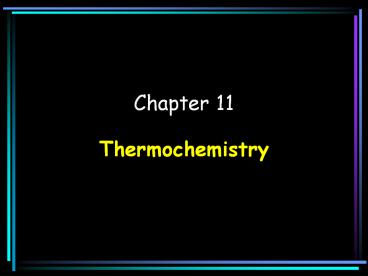Thermochemistry - PowerPoint PPT Presentation
1 / 9
Title:
Thermochemistry
Description:
Chapter 11 Thermochemistry Chapter 11 Thermochemistry Molar Heat of Fusion ( Hfus): The energy needed to melt 1 mole of a substance. Water: Hfus= 6.01 kJ/mol H ... – PowerPoint PPT presentation
Number of Views:109
Avg rating:3.0/5.0
Title: Thermochemistry
1
Chapter 11
- Thermochemistry
2
Molar Heat of Fusion (?Hfus) The energy needed
to melt 1 mole of a substance. Water ?Hfus
6.01 kJ/mol ?H values are positive because
substances need added heat in order to melt.
(Endothermic)
1 H Hydrogen 1.01
8 O Oxygen 16.00
Example How much heat does it take to melt 35.0
g of ice?
mol H2O
6.01 kJ
1
35.0 g H2O
11.7 kJ
x
x
mol H2O
1
g H2O
18.02
Calculator 35.0 18.02 x 6.01 11.67314095 kJ
3
Molar Heat of Solidification (?Hsolid) The
heat lost when 1 mole of a liquid freezes.
Water ?Hsolid - 6.01 kJ/mol ?H values are
negative because substances have to lose heat in
order to freeze.
(Exothermic)
4
Molar Heat of Vaporization (?Hvap) The energy
needed to vaporize 1 mole of a substance.
Water ?Hvap 40.7 kJ/mol
(Endothermic)
1 H Hydrogen 1.01
8 O Oxygen 16.00
Example How much heat does it take to vaporize
35.0 g of water?
mol H2O
40.7 kJ
1
35.0 g H2O
79.1 kJ
x
x
mol H2O
1
g H2O
18.02
Calculator 35.0 18.02 x 40.7 79.05105438 kJ
5
Molar Heat of Condensation (?Hcond) The amount
of heat released when 1 mole of a substance
condenses. Water ?Hcond - 40.7 kJ/mol
(Exothermic)
6
Heat of Combustion (?H) The heat released
during a chemical reaction in which 1 mole of a
substance is completely burned. Also called
Molar Heat of Combustion
(Exothermic)
7
Molar Heat of Solution (?Hsoln) The heat change
that results when 1 mole of a substance is
dissolved in water. Molar heat of solution
for calcium chloride ?Hsoln -82.8 kJ/mol
Example Certain hot packs work by mixing
calcium chloride with water. How much heat energy
is produced if you mix 6.32 moles of CaCl2 in
water?
-82.8 kJ
6.32 mol CaCl2
-523 kJ
x
mol CaCl2
1
Calculator 6.32 x -82.8 -523.296 kJ
8
(Hesss Law)
Use Hesss Law to calculate (?H) for the reaction
where graphite becomes diamond.
C(graphite) ? C(diamond)
?H ______ kJ
Use the enthalpy changes for the combustion of
graphite and diamond.
C(graphite) O2 (g) ? CO2 (g)
1)
?H1 -394 kJ
CO2 (g)
C(diamond) O2 (g) ? CO2 (g)
2)
C(diamond) O2 (g)
?H2 - 396 kJ
?H2 396 kJ
Diamond is supposed to be a product so reverse
2nd reaction and change sign for ?H.
It is called Hesss Law of Heat SUMMATION
Graphite is supposed to be a reactant so leave
1st reaction alone.
C(graphite) O2 (g) ? CO2 (g)
1)
?H1 -394 kJ
?
2)
2
C(graphite) ? C(diamond)
?H -394 396 2 kJ
9
Standard Heat of Formation
?Hf ?Hf(products) - ?Hf(reactants)
Substance ?Hf (kJ/mol)
CH3OH (g) -239
O2(g) 0.0
CO2 (g) -394
H2O(g) -286
2 CH3OH (l) 3 O2 (g) ? 2 CO2(g) 4 H2O
(l)
-239 x 2 - 478 kJ
0.0 x 3 0 kJ
-394 x 2 -788 kJ
-286 x 4 -1,144 kJ
- 478 kJ
- 1,932 kJ
(reactants)
(products)
?H ?Hf(products) - ?Hf(reactants)
- 1,454 kJ
?H - 1,932 kJ (- 478 kJ)
?H - 1,454 kJ































